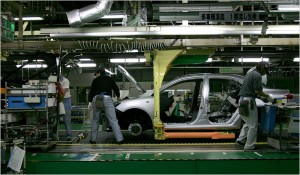I will be the first to tell you that this is probably repetition of a fairly narrow theme you have seen here before. But I think of different ways to frame it, or get different thoughts, so I share them.
“Problems first” is one of the mantras used by Phil Jenkinson, the CEO character in The Lean Manager by Michael and Freddy Ballé. Now that I have had a few weeks to let it sink in and synthesize with my mental models, I am seeing a concept that is so fundamental I would think it would be hammered into students in every management and leadership course taught in the world.
Of course, though, it isn’t.
Instead it seems alien in most company cultures.
Yet without a “problems first” culture, the leaders really have no idea – none at all – what they should be focusing their attention on. How could they? They don’t know what their people are struggling with until it is too late. By that point, a small unresolved problem has grown to the point where it cannot possibly be ignored, and now it must be dealt with. Task teams are formed, initiatives are launched. Action item lists are made and presented every week, and after enormous expense and effort, the illusion of control is returned. And so many companies are run just like this.
I am pretty sure that anyone reading this knows exactly what this feels like. Let me call it a “hidden problems” culture for now. Maybe I will think of a better term later.
Enough about what it isn’t.
Ironically, a lot of companies in the pursuit of “being lean” actually go blindly through the motions of “problems first,” but so in a way that raises questions about their understanding of this concept.
Let’s look at a simple action item review at a staff meeting.
Typically it looks like this:
For each action, the responsible person reports on the status, whether or not it is “on time” (usually against an arbitrarily assigned due date), and any “problems.” The manager asks if any help is needed, and perhaps assigns more actions to someone else to assist.
One common management tool for these things is a “Stoplight Chart” where actions are assigned color codes of Green, Yellow, or Red, usually depending on progress against the deadline (how late they are).
Red items get the most attention in the meeting (as they should, more about that in a minute), but that attention is usually in the framework of review and reporting.
At the end of the meeting, the senior leader has a good feel for what is happening (or what is not happening).
Contrast this with a world-class automobile assembly line.
Just like the actions items, every task has a deadline. Only in this case, the timing is much tighter – measured in seconds, not days. The assembler knows that if he gets more than 3-4 seconds behind, for any reason at all, he cannot possibly catch up and complete the work cycle on time. He is going to be late.
He pulls the andon cord, to let the team leader know there is a problem.
Key Point: This is not a report of a problem. This is transfer of the problem. The assembler is responsible for carrying out the work as it is designed. If he can’t, for any reason, then exceptions are transferred to the team leader.
The team leader can deviate from the standard work sequence to complete the job, but not the timing. If he cannot clear the problem by the end of the takt cycle, that section of the line will stop, and the andon will go red.
This is not a report of a problem, this is transfer of the problem. The team leader is responsible for assuring the work can be completed within the takt time. If he can’t, for any reason, then exceptions are transferred to the supervisor.
The supervisor is now responsible for clearing the problem and getting things moving again. If he can’t, then within a few minutes, another section of the line will be stopped and the responsibility for clearing the problem transfers to the next level in the chain.
And so it continues.
Of course this increasing level of responsibility does not mean that the others walk away. They are clearly working very hard to get the problem cleared. But each level of escalation brings more resources to bear on the issue.
Note that I haven’t talked about root cause and problem solving yet. Although the escalation procedures are designed to help gain better understanding of the underlying cause, the first priority is to get the problem cleared so that production can resume without compromising safety or quality in any way.
There may be a temporary countermeasure put into place to do this – some short term action that, while it might introduce some extra resources into the process, allows safe, quality production to proceed long enough to get to the underlying cause. One test of understanding that cause can be to remove this temporary crutch and see what happens.
OK, back to the staff meeting.
What is different about that?
The main thing is that typically the problems are being reported, but not escalated. The responsible person may have to come with an action plan to clear the issue, but it is still Management by PowerPoint, and the senior leader’s role is approval vs. involvement. If the senior leader does become involved, it is often driven by a perception that the responsible person is incapable rather than a process of professional development.
What would this look like if it were managed exactly the same way as the assembly line?
What if that monthly review were treated the same as the fixed stop position?
A couple of ideas come to mind.
“Green” means “on track, as originally scheduled.”
“Yellow” means “behind, but we have a plan to get back to green.”
“Red” means behind, and we don’t know how we are going to recover.”
How would those meanings change the tenor of these meetings?
“Problems first” is more than just a discussion about problems. It is a culture that is focused on finding them, clearing them, and solving them, and doing so with the same priority that comes with production.

